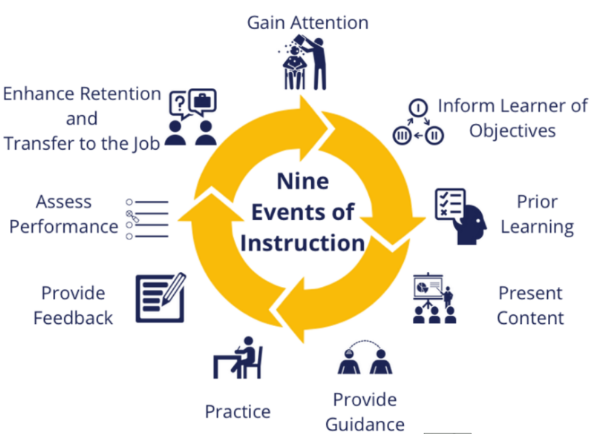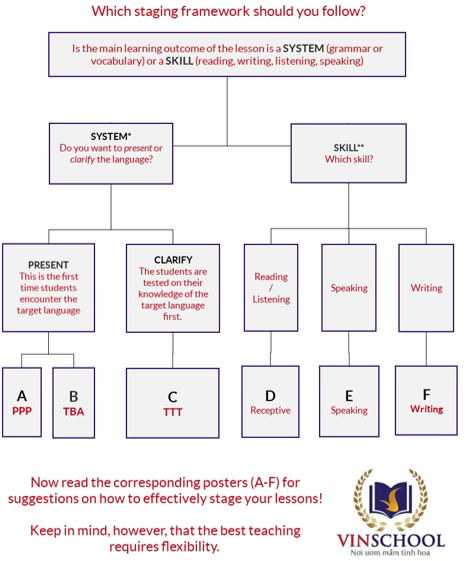Plan to sequence the lesson in an engaging and meaningful manner
Robert Gagne proposed a nine-step process called the events of instruction, which is useful for planning the sequence of your lesson.
Step 1: Gain attention: Obtain students’ attention so that they will watch and listen while the instructor presents the learning content.
- Present a story or a problem to be solved
- Utilize ice breaker activities, current news and events, case studies, YouTube videos, and so on. The objective is to quickly grab student attention and interest in the topic
- Utilize technologies such as clickers, and surveys to ask leading questions prior to lecture, survey opinion, or gain a response to a controversial question
Step 2: Inform learner of objectives: Allow students to organize their thoughts regarding what they are about to see, hear, and/or do.
- Include learning objectives in lecture slides, the syllabus, and in instructions for activities, projects and papers
- Describe required performance
- Describe criteria for standard performance
Step 3: Stimulate recall of prior knowledge:
- Help students make sense of new information by relating it to something they already know or something they have already experienced.
- Recall events from previous lecture, integrate results of activities into the current topic, and/or relate previous information to the current topic
- Ask students about their understanding of previous concepts
Step 4: Present new content: Utilize a variety of methods including lecture, readings, activities, projects, multimedia, and others.
- Sequence and chunk the information to avoid cognitive overload
- Blend the information to aid in information recall
- Bloom's Revised Taxonomy can be used to help sequence the lesson by helping you chunk them into levels of difficulty.
Step 5: Provide guidance: Advise students of strategies to aid them in learning content and of resources available. With learning guidance, the rate of learning increases because students are less likely to lose time or become frustrated by basing performance on incorrect facts or poorly understood concepts.
- Provide instructional support as needed – as scaffolds (cues, hints, prompts) which can be removed after the student learns the task or content
- Model varied learning strategies – mnemonics, concept mapping, role playing, visualizing
- Use examples and non-examples
Step 6: Practice: Allow students to apply knowledge and skills learned.
- Allow students to apply knowledge in group or individual activities
- Ask deep-learning questions, make reference to what students already know or have students collaborate with their peers
- Ask students to recite, revisit, or reiterate information they have learned
- Facilitate student elaborations – ask students to elaborate or explain details and provide more complexity to their responses
Step 7: Provide feedback: Provide immediate feedback of students’ performance to assess and facilitate learning.
- Consider using group / class level feedback (highlighting common errors, give examples or models of target performance, show students what you do not want)
- Consider implementing peer feedback
- Require students to specify how they used feedback in subsequent works
Step 8: Assess performance: To evaluate the effectiveness of the instructional events, test to see if the expected learning outcomes have been achieved. Performance should be based on previously stated objectives.
- Utilize a variety of assessment methods including exams/quizzes, written assignments, projects, and so on.
Step 9: Enhance retention and transfer: Allow students to apply information to personal contexts. This increases retention by personalizing information.
- Provide opportunities for students to relate course work to their personal experiences
- Provide additional practice
The graph below shows Vinschool’s staging frameworks which serve as ready references for lesson sequencing.
The links to view frameworks A-Fare listed below:
- Framework A: PPP
- Framework B: TBA
- Framework C: TTT
- Framework D: Receptive
- Framework E: Speaking
- Framework F: Writing
Reference:
Gagne, R. M., Wager, W.W., Golas, K. C. & Keller, J. M (2005). Principles of Instructional Design (5th edition). California: Wadsworth.

